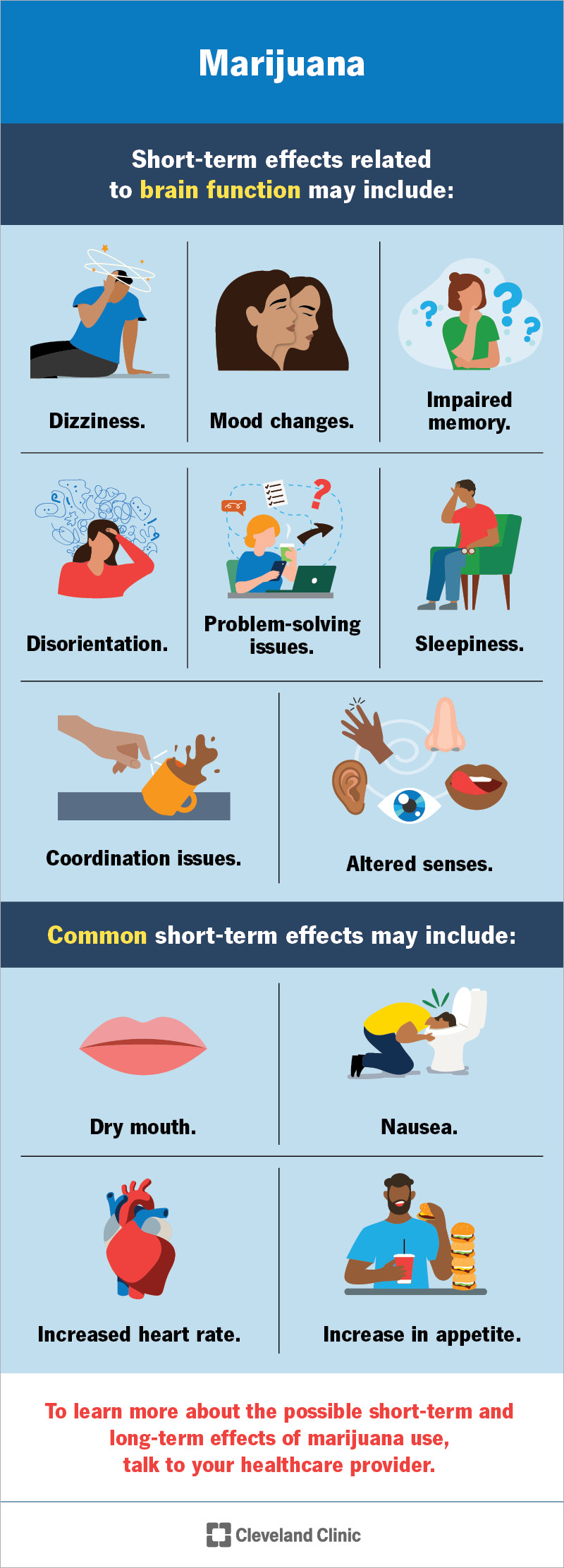Marijuana is a mind-alerting substance that comes from the Cannabis sativa plant. It has several short-term and long-term effects, many of which scientists are still studying.

Marijuana is a substance that has mind-altering effects. Other names for marijuana include weed, pot and dope. Although people often use the terms “marijuana” and “cannabis” interchangeably, there are differences:
In other words, marijuana is cannabis, but not all forms of cannabis are marijuana (contain THC).
Marijuana is one of the most used drugs in the United States, particularly among young adults. In 2021, 35.4% of people aged 18 to 25 (11.8 million people) reported using marijuana in the past year.
Scientifically, there are many unknowns regarding marijuana. Researchers are still studying the long-term and short-term effects of this substance.
Scientists have historically classified marijuana (THC) as a hallucinogen. However, not all instances of marijuana use cause hallucinogen-like effects.
When people do experience hallucinations from marijuana use, they’re typically different from hallucinations people experience from other hallucinogens (like LSD, psilocybin and ecstasy). This suggests that the hallucinatory effects of marijuana may work differently from those of other hallucinogens.
Advertisement
Cleveland Clinic is a non-profit academic medical center. Advertising on our site helps support our mission. We do not endorse non-Cleveland Clinic products or services. Policy
Several states in the U.S. have laws regarding the use of marijuana for medical purposes. These purposes are mainly to help with symptom management, not to directly treat a condition. Medical uses of marijuana may include:
The U.S. Food and Drug Administration (FDA) classifies marijuana as a Schedule I substance. This means that it has no currently accepted medical uses and a high potential for addiction. Because of this, healthcare providers can’t prescribe marijuana. But providers may certify marijuana use to help with certain medical conditions in states that legally allow it.
The FDA hasn’t approved marijuana to treat any medical conditions. But it has approved certain purified substances derived from marijuana (analogs).
FDA-approved analogs of marijuana include:
Not all hospital systems and healthcare providers certify medical marijuana in states where it’s legal. This is mainly due to the lack of thorough research and clinical trials on the medical uses of marijuana.
Marijuana affects each person differently based on several factors, like:
The effects you might experience from marijuana aren’t always the same as what someone else might feel. In addition, different instances of marijuana use can cause different effects in the same person.
Studies show that marijuana use has certain short-term and long-term effects. But researchers are still learning about these, especially long-term effects.
When you smoke marijuana, THC quickly passes from your lungs into your bloodstream. Your blood carries THC to the brain and other organs. Your body absorbs THC more slowly if you eat or drink it — you typically experience the effects after 30 minutes to one hour.
THC resembles a naturally occurring chemical in your body called anandamide. THC can “work” as anandamide and fit into anandamide receptors in certain parts of your brain. Thus, the THC in marijuana overly activates parts of your brain that contain the highest number of these receptors, leading to a series of effects.
Short-term effects of marijuana related to brain function may include:
If you consume marijuana in high doses, you may experience:
Other common short-term effects of marijuana may include:
Researchers are still learning about the long-term effects of marijuana use. So far, studies show:
Studies show long-term use of marijuana is associated with:
Advertisement
Scientists and healthcare providers can’t state any general benefits of marijuana with certainty. This is because there isn’t enough research yet about the medical benefits of the substance, especially long-term effects. In addition, marijuana tends to affect different people in many different ways.
While individual people may report certain personal benefits, all of these factors make it difficult to come to any firm conclusions.
Aside from the immediate and long-term health effects of marijuana, other risks include:
Approximately 1 in 10 adult users of marijuana develop cannabis use disorder. This is one type of substance use disorder (SUD). SUD is a mental health condition in which a person has a problematic pattern of substance use that causes distress and/or impairs their life. Severe SUDs are also known as addiction.
Adolescents using cannabis are four to seven times more likely than adults to develop cannabis use disorder.
Cannabis use disorder can significantly impact your health, relationships and overall quality of life. It’s crucial to seek help as soon as you develop signs of this condition.
The FDA strongly advises against the use of CBD, THC and marijuana in any form during pregnancy or while breastfeeding (chestfeeding).
Marijuana use during pregnancy may:
Breastmilk can contain THC for up to six days after use. So, you should avoid marijuana use while breastfeeding. THC may affect your baby’s brain development.
Marijuana smoke contains many of the same harmful components as tobacco smoke. Because of this, you should avoid smoking marijuana around a baby or children.
A note from Cleveland Clinic
Marijuana has several short-term and long-term effects, many of which scientists are still studying. Because of this, it’s important to use caution with marijuana and other cannabis products. If you want to learn more about the potential medical uses of marijuana or are concerned you have marijuana use disorder, talk to your healthcare provider. They’re available to help.
Last reviewed on 11/05/2023.
Learn more about the Health Library and our editorial process.
Advertisement
Cleveland Clinic is a non-profit academic medical center. Advertising on our site helps support our mission. We do not endorse non-Cleveland Clinic products or services. Policy